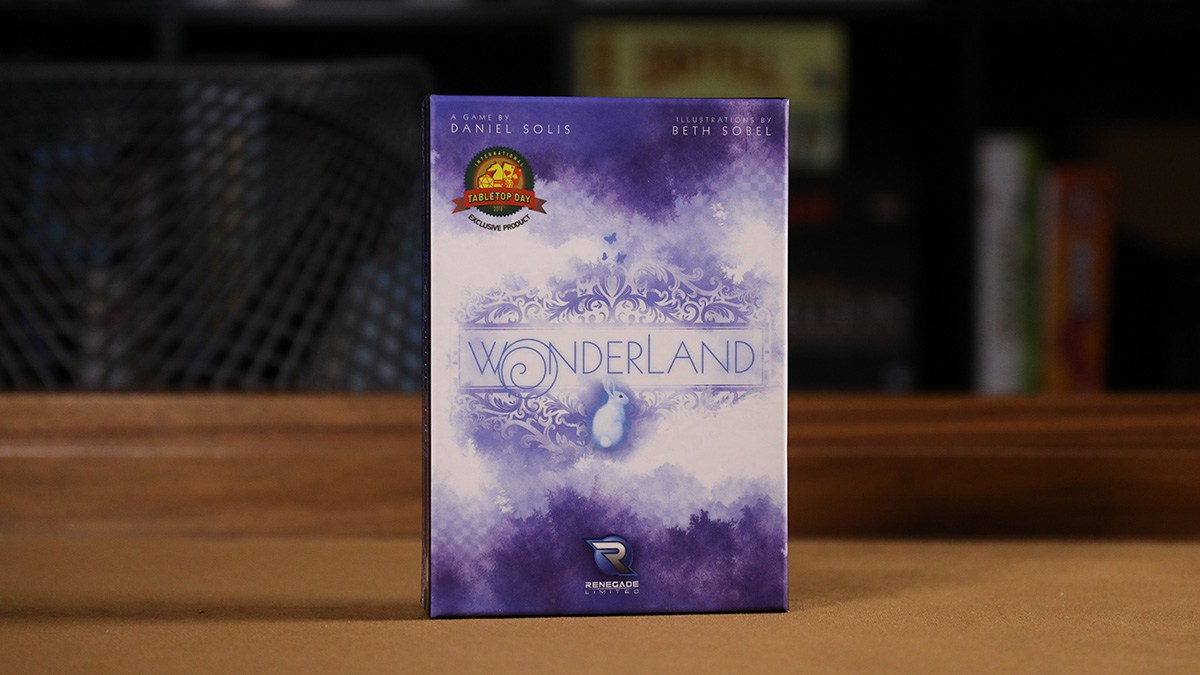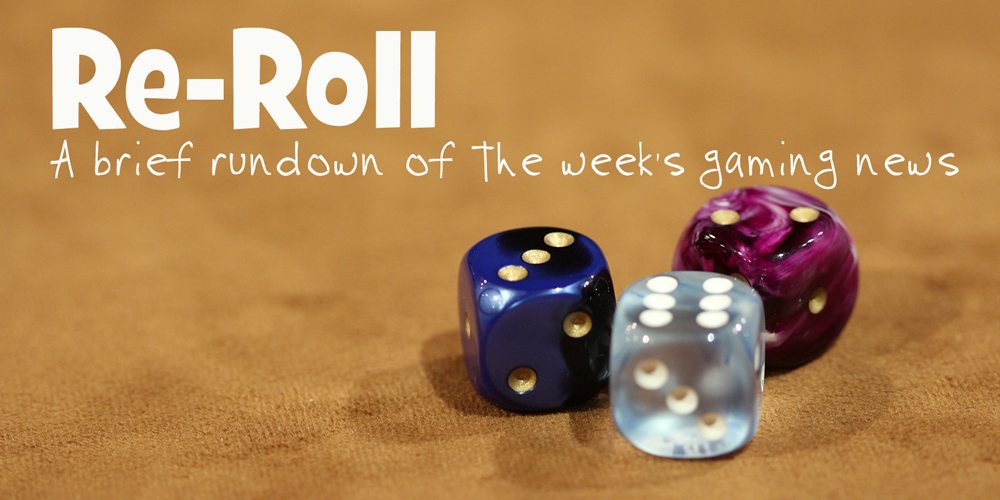 In honor of this weekend’s Tabletop Day, Renegade Game Studios is releasing a special Tabletop Day exclusive, a quick playing card game called Wonderland, by Daniel Solis that pits Alice against the Red Queen.
In honor of this weekend’s Tabletop Day, Renegade Game Studios is releasing a special Tabletop Day exclusive, a quick playing card game called Wonderland, by Daniel Solis that pits Alice against the Red Queen.
Wonderland is a small card game that features area control and a bit of hand management. It plays in about 10-20 minutes and is intended for two players, aged 14 and up.
Wonderland Components
In the small box, you’ll find just 18 cards, seven for each player and four additional cards used as an expansion. There’s a velvet bag to carry the cards in, but Wonderland is a game that will easily fit in your pocket and can be played on the smallest of tables.
The box is magical and very evocative of Alice’s adventures, which is almost a shame, as you’ll probably recycle it or stick it in the back of a closet. Thankfully the box art gets picked up on the back of the cards, so you still get to take it with you.

The cards are normal playing size and each has a unique piece of really fantastic artwork on them, meant to reference part of the Alice saga. Alice’s cards have art that is key to her, as does the Red Queen. Each card has a number, from one to seven. These cards have a thin frame around them, near the border and this is the only way to tell the cards apart. I wish there was a more definitive designator because, when looking at the cards, you really have to look to see the difference between Alice’s cards and the Red Queen’s. There are four additional cards, called Wonders, which are for the expansion. Each has a unique piece of art that fits the story and a thin frame, which looks like Alice’s cards, but no numbers.
The velvet bag is sized well so that you don’t have to worry about bending cards when placing them in the bag. It has some beautiful embroidery on one side and is made from heavier velvet, making a very nice add-on.

How to Play Wonderland
The goal of Wonderland is to score the most points. Scores are calculated by determining each side’s sum of each row and column of the play area. The player with the most points in a row or column is awarded the edge card’s points. Some cards have magic items, which will nullify or augment other cards.
To get started, cards are split between those for Alice and the Red Queen, with players choosing a side. Play takes place in a 4×4 grid. On the upper and left side edge of the grid, players play three cards, face down on their respective edges (Alice along the top, the Red Queen on the left). This is called the Arrival phase and takes place over three rounds.

Next, beginning with the Red Queen, players take turns playing their remaining cards into the enclosed 3×3 grid, which is referred to as Wonderland. These cards are played face-up and is called the Placement phase. When playing without the expansion, there will be one empty space in Wonderland at the end of each game.
When all cards have been placed, the face-down cards on the edges are revealed, providing the points awarded for each row and column. After players total their points for a row or column, the points (the previously face-down edge card) is awarded to the player with the highest sum.

Some cards also have a potion on their borders. The potion makes any adjacent card worth zero (magic items have no effect on edge cards placed during the Arrival phase). Some cards have cakes on their borders, which doubles the value of an adjacent card. Cakes can be cumulative and their doubling effects can add up, but potions always trump and nullify cakes. The challenging thing is that cards are symmetrical. That is, the Red Queen has different magic items on her cards than Alice does and they are on differing borders.
One final rule for card placement in Wonderland — while cards must be placed in portrait orientation, hey can be rotated and played upside-down or right-side-up, which presents lots of possibilities for placing magic items.

Curiouser and curiouser!
When you’ve got the hang of the game (it won’t take long), you might want to consider throwing in the Wonders expansion. With Wonders, after the Arrival phase, the player playing Alice chooses one of the four expansion cards (which she keeps secret) and places it in Wonderland after the Placement phase. Each of the four cards has a different effect:
- Tugley Wood – Doubles the highest card in the row and column where it is placed. Tugley Woods stacks Cake effects.
- Tea Party – Ignores the magic item effects on a single card adjacent to the Tea Party card.
- White Rabbit – Swaps the edge cards on White Rabbit’s row and column.
- The Maze – The player with the lowest value for this row and column wins the respective points.
Wonder cards give Alice a small advantage and encourages players to play multiple games, so each has the opportunity to plat as Alice.
Why You Should Play Wonderland
Can you believe that Tabletop Day is five years old? It seems to have outgrown its original purpose and connection, which is probably a good thing for our hobby. And while the day has waned some in recent years, plenty of places still have events and its always fun to see what special and exclusive goodies publishers roll out as exclusives.
Wonderland is a very enjoyable pocket game with a good deal of replayability. It’s easy to teach and the length of games and versatility of the Wonder cards means you can play quite a few games in a short time, each different than the last. Although the suggested age is 14, I feel as though it could be played with kids younger than that, as there is no objectionable material. It’s only the concept and strategy that might be tougher for really young kids to grasp.

The options players face when selecting edge cards during the Arrival phase presents some difficult choices. Should you place high cards face-down along the edges, hoping to win them during the Placement phase? Or do you save your high cards to try to win middle points on the edges? Of course, your plans can all be dashed when your opponent plays a magic item that destroys your strategy.
When you play with the Wonders, the game takes on new challenges. The red Queen will want to try to limit Alice’s benefits she will get from the Wonder card played at the end of the game. For Alice, she will want to maneuver for the best placement of her wonder. In all cases, the game takes on a bit of a bluffing atmosphere, as players place cards and represent for what they might be trying to do, while hiding their true strategy. It’s challenging and fun.
The artwork is really very nice and the velvet bag gives the game even more value than the game you get to play. It’s very affordable and, because it’s only available on Tabletop Day, it’s worth grabbing just for the exclusivity. Daniel Solis is a designer worth following and he has a number of smaller games, like Wonderland, which are quite good; Kodama and Koi Pond are a couple of examples. He’s also responsible for Renegade’s upcoming Junk Orbit.
We’ve played Wonderland several dozen times now and it hasn’t become old yet. When you head over to your FLGS this weekend, try to snag a copy. It won’t be out long and it’s worth grabbing.
Wonderland is only available through retailers on Tabletop Day and will retail for just $12.00.
Click here to see all our tabletop game reviews.
If you’d like to stay up-to-date with all of our tabletop gaming coverage, please copy this link and add it to your RSS reader.
Disclosure: GeekDad received a copy of this game for review purposes.





